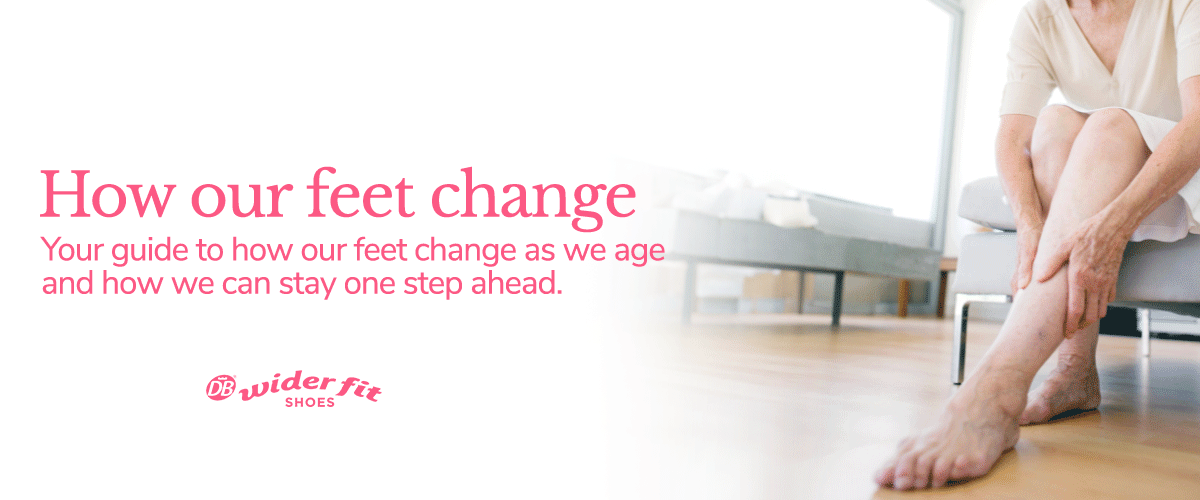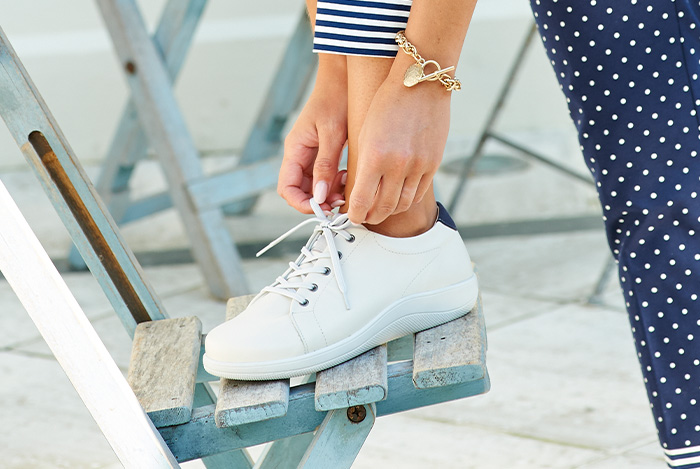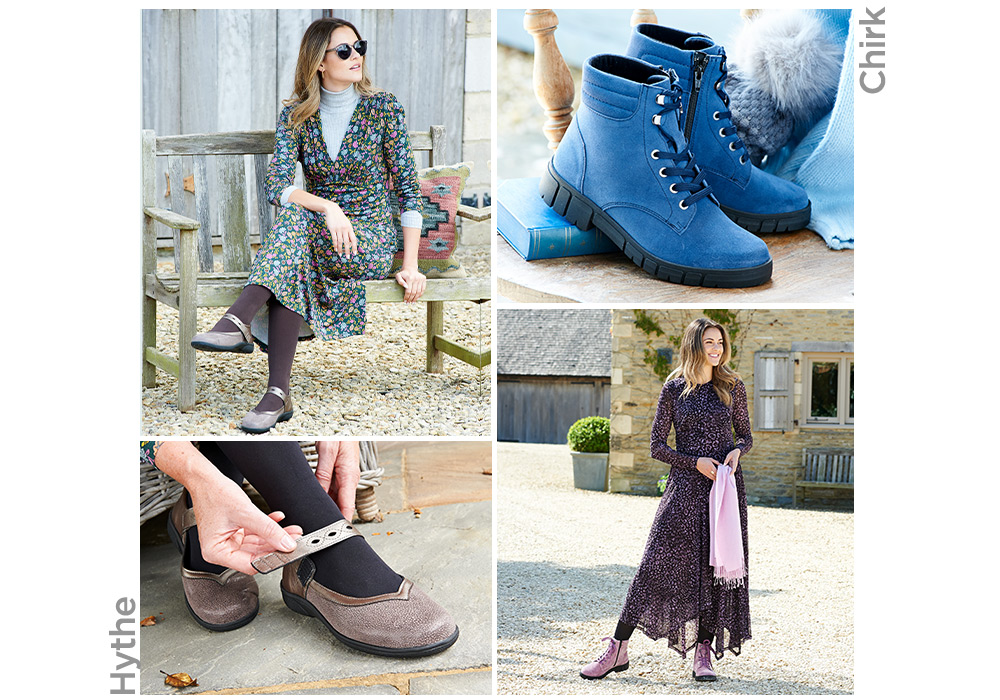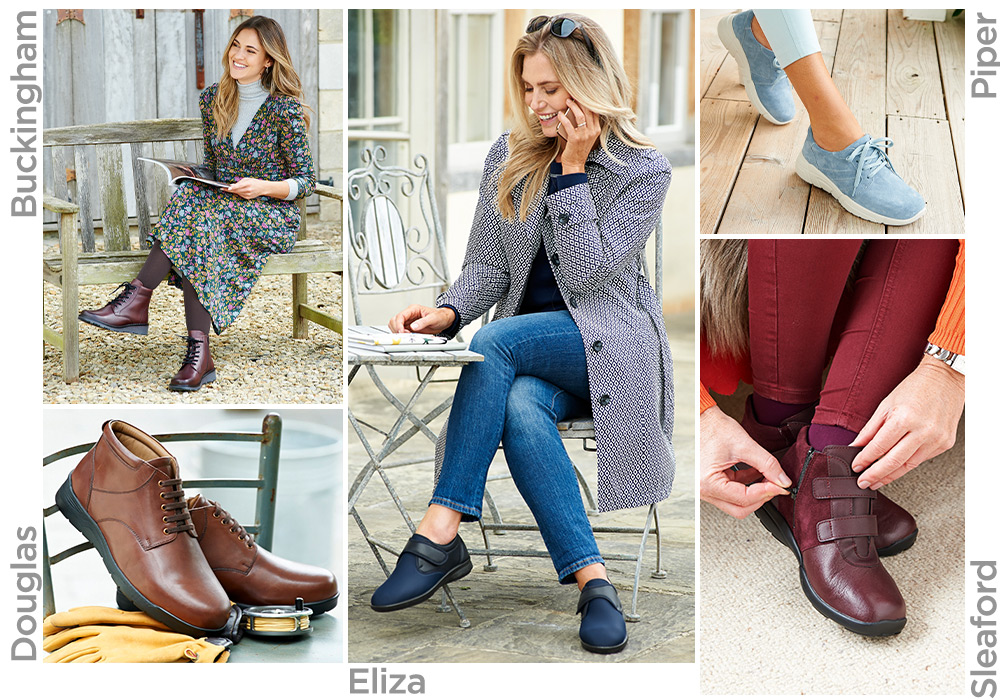We use cookies to make your experience better. To comply with the new e-Privacy directive, we need to ask for your consent to set the cookies. Learn more
Six Ways Our Feet Change as We Age

Self-Care and the Role of Wide Fitting Footwear
As we age, our bodies undergo numerous changes, and our feet are no exception.
Aging affects your entire body; your hair, body shape, skin, teeth and muscle mass all change. We even shrink as we age more! So, why wouldn’t your feet change too?
These changes can affect our mobility, comfort, and overall quality of life.
Whilst many people understand that these other changes will take place, many don’t consider that their feet will also change in many ways, resulting in many of us not having our feet measured as we age or taking steps to improve our foot health.
Of course, as our feet are our foundations, these changes can have an impact on our overall physiological structure, balance and general wellbeing.
So, what changes are you likely to see in your feet as you age? And what can you do about them to ensure optimal comfort and foot health?
1. Foot width can increase with age
Over time, the natural fat pads on the soles of our feet begin to thin, and the ligaments and tendons lose some of their elasticity. This can lead to a flattening of the arch and an overall change in foot shape.
Therefore, many people find that their feet become wider with age.
What you can do:
1. Foot Exercises: Regular foot exercises, such as toe curls and arch lifts, can help maintain muscle tone and flexibility.
2. Proper Footwear: Choosing shoes with a roomy toe box and good arch support, or the space to accommodate specialist support insoles, can accommodate changes in foot shape and provide comfort.
3. Wide fitting footwear is essential for aging feet as it offers ample space for feet that have widened, increasing comfort whilst reducing pressure on the toes and forefoot. This can help prevent blisters, calluses, and other foot problems associated with tight shoes.
Everyday shoe Taylor features our asymmetric toe shape that ensures room for any shaped foot, with extra space for wide and deep feet, bunions and hammer toes and seam-free, soft leather uppers that gently accommodate even sore areas without rubbing.
2. Arthritis can develop as we age, affecting our feet and ankles
Arthritis is a common condition that affects the joints, including those in the ankles and feet. Whilst anyone can be affected by arthritis, it is a condition more prevalent as we age and that can be caused by degradation of cartilage due to ongoing joint pressure through everyday life.
Osteoarthritis typically affects the joints in the big toe and the ankle, while rheumatoid arthritis can cause more widespread foot issues, including deformities and severe pain.
What you can do:
1. Anti-inflammatory Diet: Eating a diet rich in anti-inflammatory foods, such as fish, nuts, and leafy greens, can help manage arthritis symptoms.
2. Gentle Exercise: Low-impact exercises, like swimming and cycling, can maintain joint mobility and maintain cartilage health, without putting too much strain on the feet.
3. Wide Fitting Footwear: We offer over 200 arthritis-friendly footwear styles, designed with extra width to accommodate swollen joints and custom orthotic inserts, alongside the necessary support required in reducing pain caused by arthritis.
Many of our styles are available with either adjustable strap-fastenings or in slip-on styles to aide easy foot entry and adjustment for people with reduced hand motility.
Men’s arthritis-friendly ankle boot Solomon features soft leather uppers with our super cushioned, super lightweight sole and adjustable strap fastenings.
Ladies soft leather T-bar shoe Brookfield is arthritis, diabetes and bunion-friendly, as well as being easy on the eye. Also featuring an air-bubble sole for extra cushioning and extended straps that can be cut to the correct length* for your foot.
3. Bunions and Hammer Toes, Corns and Calluses
Bunions and hammer toes are structural deformities that often develop with age. Bunions occur when the big toe deviates towards the other toes, while hammer toes are characterized by a bending of the toe joints.
Corns and calluses form as a result of prolonged pressure and friction on the skin.
What you can do:
1. Padding and Taping: Using protective pads and toe spacers can help alleviate pressure on bunions and hammer toes.
2. Moisturizing: Regularly moisturizing your feet can soften calluses and prevent the formation of corns.
3. Footwear Adjustments: Ensure shoes have a wide and deep toe box to prevent rubbing and pressure.
Wide fitting shoes reduce the friction and pressure on the toes, preventing the exacerbation of bunions, hammer toes, corns, and calluses. Our wide and extra-wide fitting shoes can also accommodate orthotic devices that help in realigning the toes.
The width and depth of our shoes ensure that almost all of our styles are helpful for corns and calluses, and we offer a range of specially designed wide-fitting footwear for bunions and hammer toes.
These feature wide and deep toe boxes to ensure enough room to accommodate the bunion or hammer toe, as well as the use of soft leathers or stretch fabrics to mould to the shape of your foot to eliminate rubbing against sore areas.
Cute Mary-Jane ballerina pump Hythe is an ideal style for this range of conditions, with stretch fabric toe-box, air-bubble sole and suitability also for arthritis, diabetes, oedema and swollen feet!
New for autumn 2024 Chirk features a round, deep and seam-free toe-box to allow space for bunions and hammer toes, along with a chunky, grippy rubber sole, laces fastening and inside zip for easy access.
W4. Even Our Toe-nails Change!
Aging can cause toenails to become thicker, more brittle, and discoloured. This makes them harder to trim and more susceptible to fungal infections.
Longer toe-nails are likely to be pressed and squeezed by your current footwear, leading to serious discomfort.
What you can do:
1. Regular Trimming: Keep toenails trimmed straight across to prevent ingrown toenails. Soaking your feet beforehand can soften the nails, making them easier to cut.
2. Moisturizing and Filing: Moisturize your toenails and use a fine-grit file to keep them smooth and prevent cracking.
3. Antifungal Treatments: Use antifungal creams or sprays to combat fungal infections and keep nails healthy.
4. Wear footwear that can accommodate your new toe-nail size. Our specially designed wide and deep footwear offers the extra room in the toe area that can prevent trauma to the toenails, reducing the risk of ingrown nails and other nail problems, whilst reducing pain and improving overall comfort.
Also look out for soft materials such as soft leathers or stretch fabric toe-boxes that can mould to the shape of your foot, reducing pressure and improving comfort.
Best-selling everyday shoe Rory is one of many styles to feature our round, deep toe box and is made from incredibly soft leather that offers the give to accommodate thicker toe-nails.
5. Changes to our skin as we age
As we age, the skin on our feet becomes thinner, drier, and less elastic. This makes it more prone to injuries, infections, and conditions like cracked heels.
Additionally, as we age, our cells take longer to regenerate and so wounds can take much longer to heal.
It is therefore vital that we ensure that our footwear does not rub, wounding the skin.
What you can do
1. Moisturizing: Use a rich, emollient foot cream daily to keep the skin hydrated and supple.
2. Gentle Exfoliation: Regularly exfoliate with a pumice stone or foot scrub to remove dead skin cells and prevent thick, hard patches.
3. Protective Footwear: Wear socks made from natural fibres like cotton or wool to allow your skin to breathe and stay dry.
4. Ensure well-fitting footwear. Wide fitting shoes can reduce friction and pressure, helping to protect the delicate skin on your feet from injuries and blisters. Look for shoes with soft, breathable linings to maintain skin health.
It is also important to ensure that shoes fit well – that they aren’t too small OR too big - to eliminate rubbing. We recommend measuring your feet at home or having your feet fitted into shoes at a DB Wider Fit Shoes independent stockist.
For security of fit and reduced rubbing, we recommend lace-up fastenings, as these offer the most secure fit with adjustability. For people with limited hand motility or ease of fastening laces we offer a variety of adjustable strap-fastenings for the perfect combination of security of fit with ease of use.
Finally, shoes with no internal seams in the toe-box can be very important when dealing with easily damaged skin, as the smooth internal area of the shoe will reduce rubbing and abrasions considerably.
Lace-up fastening Buckingham and adjustable strap-fastening Hitchin, alongside many others, feature seam-free toe boxes to reduce rubbing.
6. Fallen Arches
The arches of our feet can weaken and flatten over time, a condition known as fallen arches or flat feet. This can lead to pain and discomfort in the feet, legs, and lower back as well as the widening of the feet.
What you can do:
1. Arch Supports: Use orthotic inserts or arch supports to provide additional cushioning and support for fallen arches. Our wide and extra-wide fitting styles are designed twith the extra width and depth required to accommodate orthotics and other specialist insoles.
2. Strengthening Exercises: Perform exercises like heel raises and toe stretches to strengthen the muscles supporting the arches.
3. Weight Management: Maintaining a healthy weight can reduce the strain on your arches and alleviate discomfort.
4. Shoes offering arch support and extra width can help distribute weight more evenly across your feet, providing relief for fallen arches. Look for shoes with cushioned soles to absorb shock and reduce impact. Learn more about shoes for flat feet.
Rather than offer shoes designed especially for fallen/high arches or other issues, we supply shoes that have specially designed removable insoles so that you can remove one or both insoles and insert your own specialist insole.
Look out for the "Removable Insoles" icon in our brochure or on the product pages of our website for the description including "removable insole for the insertion of orthotics".
All of our dual width fitting styles - 2V(EE-4E) or 6V(6E-8E) - come with removable insoles or adjustable straps along with many other features that make them suitable for the insertion of specialist insoles.
We also offer many styles with air-bubble soles for extra cushioning as you walk, making it feel as though you’re walking on air.
Men’s everyday shoe Patrick is just one of many wide-fitting styles suitable for flat feet, due to its super cushioned, super lightweight sole with adjustable laces fastening to ensure the perfect fit.
Final thoughts
As our feet age, they require more attention and care to remain healthy and comfortable. By incorporating regular self-care practices and choosing wide fitting footwear, we can address many of the common foot problems associated with aging. Wide fitting shoes offer the necessary space and support to accommodate changes in foot shape, arthritis, deformities, nail issues, skin degradation, and fallen arches.
Investing in proper footwear and maintaining a consistent foot care routine can significantly improve mobility, reduce pain, and enhance the overall quality of life as we age.
NEW TO OUR SHOES? Find out more about how we can help!
Risk free footwear
We know that it’s really difficult to order footwear online and find the perfect fit, but we want to make it as easy, risk-free and stress-free as possible. That’s why we offer free postage on returns and exchanges on all UK orders so that, if you’re in the UK and have ordered from us and the shoes aren’t right for whatever reason, you can give us a call to discuss the problem and return them to us, unworn except for trying on to exchange for a different size, style or fitting without paying a penny more in postage.
Once you’ve found your perfect fit, you’ll never look back!
We hope that you agree that our wide-fitting shoes, trainers and sandals offer the perfect fit for every wide, deep or problem foot!
VAT Exempt footwear
Did you know, if you need 6E, 6V or 8E fitting footwear and have a qualifying condition, that you might be eligible for VAT relief?
This means that you could essentially benefit from a discount of 20%. And what's more, our promotional discount codes still apply, meaning you can gain further savings.
We make it easy to claim your VAT relief by clearly listing the VAT exempt price against qualifying products, and provide a very short form to fill out as part of the checkout process when ordering your 6E, 8E or 6V fitting shoes.
Qualifying conditions for VAT free purchases include physical or mental impairment that affects your ability to carry out everyday activities, for example, blindness; conditions treated as chronic sickness, such as diabetes, arthritis or lymphoedema; and long-term illnesses.
Look out for the link underneath our available fittings on each product page to claim your VAT exemption.
Need Our Help?
If you’re unsure about anything at all to do with our styles, features or fittings and whether they’re right for you, please do contact us on +44 (0)1933 311 077, Monday to Friday, 9-5 to speak with one of our friendly, knowledgeable UK based customer services team, who will be delighted to help.
OR would you like some in-person help to find the perfect fit for your feet? Then why not book an appointment and visit our Fitting Centre in Rushden, Northamptonshire.
We offer a traditional, personal service to help you find the perfect shoes either for naturally broad feet, to accommodate orthotics and or for foot health issues such as arthritis, lymphoedema, diabetes, bunions and many more.
Our appointment system ensures you'll receive our team's full attention and there's no obligation to buy.
Check out our Fitting Centre details today for further information.
Why not check out some of our other blog posts to help you with you feet.
Why the right shoes is important for diabetes sufferers »
8 reasons why it's worth paying more for quality wide fit shoes »
Best shoes for Arthritis »
More of what our customers say:
 I highly recommend this company. They have saved me (Size 6 with very high instep and very wide feet EEEEE needing room for orthotic inserts) after years of painful feet, terrible posture and hideous shoes.
I highly recommend this company. They have saved me (Size 6 with very high instep and very wide feet EEEEE needing room for orthotic inserts) after years of painful feet, terrible posture and hideous shoes.  Penny
Penny
 What a treat. Wish I had found you years ago. Fashionable and comfortable, what a combination. I couldn't believe I could actually walk without pain. I have now ordered three more pairs, for different circumstances.
What a treat. Wish I had found you years ago. Fashionable and comfortable, what a combination. I couldn't believe I could actually walk without pain. I have now ordered three more pairs, for different circumstances.  Mrs H
Mrs H
 My husband is very pleased as he doesn't have to listen to me gasping with pain every time my foot hits a slightly uneven surface or complaining of sore toes and heels. Thank you so much, it is not an overstatement to say your shoes have changed my life!
My husband is very pleased as he doesn't have to listen to me gasping with pain every time my foot hits a slightly uneven surface or complaining of sore toes and heels. Thank you so much, it is not an overstatement to say your shoes have changed my life!  Mrs B
Find out what more of our customers say »
*Once the straps have been cut, the product cannot be returned.
References
- Stride Clinic. “Corns And Callus And The Older Foot”. Sandbach Podiatry Limited, https://www.strideclinic.com
- U Chicago Medicine. “Do our feet change in middle age: Common foot problems in adults and how to treat foot pain.” The University of Chicago Medicine, https://www.uchicagomedicine.org
- Piedmont Orthopedics / Ortho Atlanta. “Feet and the Natural Changes with Aging.” OrthoAtlanta, https://www.orthoatlanta.com
- Primecare Orthotics and Prosthetics. “What Are Common Foot Problems in Older Adults? Foot Care Tips for Seniors?” PrimeCare LLC, https://primecareprosthetics.com
- American Podiatric Medical Association (APMA). “Aging and Foot Health.” APMA, www.apma.org.
- Mayo Clinic Staff. “Arthritis.” Mayo Clinic, Mayo Foundation for Medical Education and Research, www.mayoclinic.org.
- National Institute on Aging. “Foot Care: Do’s and Don’ts.” National Institutes of Health, www.nia.nih.gov.
- Cleveland Clinic. “Common Foot Problems in Older Adults.” Cleveland Clinic, www.clevelandclinic.org.
- WebMD. “Foot Health: Your Feet Change as You Age.” WebMD, www.webmd.com.
- Arthritis Foundation. “Foot Pain and Arthritis.” Arthritis Foundation, www.arthritis.org.
- Harvard Health Publishing. “How to Take Care of Aging Feet.” Harvard Medical School, www.health.harvard.edu.
- Foot and Ankle Society. “Foot Health in Older Adults.” American Orthopaedic Foot & Ankle Society, www.aofas.org.
- NHS. “Foot Care - Feet for Life.” National Health Service, www.nhs.uk.
Mrs B
Find out what more of our customers say »
*Once the straps have been cut, the product cannot be returned.
References
- Stride Clinic. “Corns And Callus And The Older Foot”. Sandbach Podiatry Limited, https://www.strideclinic.com
- U Chicago Medicine. “Do our feet change in middle age: Common foot problems in adults and how to treat foot pain.” The University of Chicago Medicine, https://www.uchicagomedicine.org
- Piedmont Orthopedics / Ortho Atlanta. “Feet and the Natural Changes with Aging.” OrthoAtlanta, https://www.orthoatlanta.com
- Primecare Orthotics and Prosthetics. “What Are Common Foot Problems in Older Adults? Foot Care Tips for Seniors?” PrimeCare LLC, https://primecareprosthetics.com
- American Podiatric Medical Association (APMA). “Aging and Foot Health.” APMA, www.apma.org.
- Mayo Clinic Staff. “Arthritis.” Mayo Clinic, Mayo Foundation for Medical Education and Research, www.mayoclinic.org.
- National Institute on Aging. “Foot Care: Do’s and Don’ts.” National Institutes of Health, www.nia.nih.gov.
- Cleveland Clinic. “Common Foot Problems in Older Adults.” Cleveland Clinic, www.clevelandclinic.org.
- WebMD. “Foot Health: Your Feet Change as You Age.” WebMD, www.webmd.com.
- Arthritis Foundation. “Foot Pain and Arthritis.” Arthritis Foundation, www.arthritis.org.
- Harvard Health Publishing. “How to Take Care of Aging Feet.” Harvard Medical School, www.health.harvard.edu.
- Foot and Ankle Society. “Foot Health in Older Adults.” American Orthopaedic Foot & Ankle Society, www.aofas.org.
- NHS. “Foot Care - Feet for Life.” National Health Service, www.nhs.uk.













